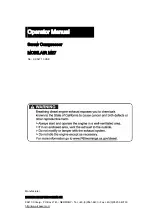
9
WARNING:
RISK OF INJURY FROM LIFTING
WHAT CAN HAPPEN
HOW TO PREVENT IT
• Serious injury can result from
attempting to lift too heavy an
object.
• The compressor is too heavy
to be lifted by one person.
Obtain assistance from others
before lifting.
CAUTION:
RISK FROM NOISE
WHAT CAN HAPPEN
HOW TO PREVENT IT
• Under some conditions and
duration of use, noise from
this product may contribute to
hearing loss.
• Always wear certified safety
equipment: ANSI S12.6
(S3.19) hearing protection.
SAVE THESE INSTRUCTIONS FOR FUTURE
USE
Know Your Air Compressor
READ THIS OWNER’S MANUAL AND SAFETY RULES BEFORE
OPERATING YOUR UNIT. Compare the illustrations with your
unit to familiarize yourself with the location of various controls
and adjustments. Save this manual for future reference.
FEATURES
AUTO (-) / OFF (O) SWITCH
Place this switch (B) in the AUTO (-) position to
provide automatic power to the pressure switch
and OFF(O) to remove power at the end of each
use. NOTE: ALWAYS ensure the switch (B) is in the
OFF (O) position before removing or replacing
pressure switch cover.
PRESSURE SWITCH
The pressure switch (B) automatically starts the motor when the air
tank pressure drops below the factory set cut-in pressure. It stops
the motor when the air tank pressure reaches the factory set cut-out
pressure.
SAFETY VALVE
This valve (G) is designed to prevent system
failures by relieving pressure from the system
when the compressed air reaches a predeter-
mined level. The valve is preset by the manu-
facturer and must not be removed or modified
in any way.
CHECK VALVE
When the air compressor is operating, the
check valve (K) is open, allowing compressed
air to enter the air tank. When the air compressor
B
G
K










































